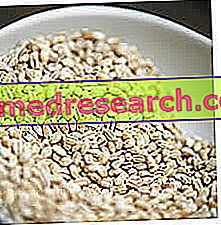Barley
Barley refers to a group of herbaceous plants belonging to the Poaceae family (Gramineae), Genus Hordeum ; among these, the widespread species for food (for humans) is the Hordeum vulgare, called "common barley".

Barley is an oriental cereal and its specific origins could be located in the Middle East, Tibet or China (depending on the bibliographic sources consulted). The prehistoric findings indicate that, most probably, it is the first cereal cultivated by man.
The barley plant is an annual cycle; reaches and exceeds one meter in height but this characteristic depends on the variety. It is an autumn-winter product that resists brilliantly even at very high temperatures and with low water intake. Certain barley cultivations are carried out up to 4500m above sea level and fear only: high concentrations of ambient humidity, intense wind or rain and low presence of mineral salts in the soil.
Barley consumes the fruits, or the seeds, which are rich in starch and contain gluten. This last characteristic renders barley UNFIT for feeding against celiac disease and suitable for bread making.
| Composition for: 100g of Barley flour - Reference values of the INRAN Food Composition Tables | |||||||||||||||||||||||||||||||||||||||||||||||||||||||||||||||||||||||||||||||||||||||||||||||||||||||||||||||||||||||||||||||||||||||||||||||||
 | |||||||||||||||||||||||||||||||||||||||||||||||||||||||||||||||||||||||||||||||||||||||||||||||||||||||||||||||||||||||||||||||||||||||||||||||||
Nutritional values (per 100 g of edible portion)
| |||||||||||||||||||||||||||||||||||||||||||||||||||||||||||||||||||||||||||||||||||||||||||||||||||||||||||||||||||||||||||||||||||||||||||||||||
In human nutrition, barley is mainly used: in the form of flour; whole and pearly in the formulation of first courses; roasted and ground for the production of coffee substitutes and for the production of malt necessary for transformation into beer or distillates.
Barley flour
Barley flour has a yield of 69-73% compared to the raw material. Many do not know that it is often a by-product of the manufacture of pearl barley or barley semolina.
Barley flour is marketed as a whole or in a refined form, but always from seeds without glumella, therefore peeled. The wholemeal flour is light, with noticeable greyish streaks, while the refined is almost totally white-yellowish. To the touch it is fine, delicate, it tends to clot easily and, if badly preserved, it quickly acquires a rancid smell.
WARNING! The barley bran ( glumelle ) is totally zootechnical; it is not a harmful product but, due to the prevalence of cellulose (insoluble, not viscous), it would be poorly tolerated in the intestine.
Barley flour is particularly widespread in the diet of naturists and those who make use of alternative nutritional regimes, such as macrobiotic, vegan, etc.
The gluten from barley flour is disintegrated, brown and not very homogeneous; as seen for that of rye, also that of barley contains modest quantities and is characterized by a poor leavening capacity. Not surprisingly, its use in the formulation of bread is often characterized by mixing with wheat flour (barley / wheat ratio = 1/2 or 1/3).
Compared to bread-making, barley flour is more suitable for the production of: barley cream, partially roasted flour, pasta, etc.
From a nutritional point of view, barley flour does not differ much from wheat flour. The balance between the energy molecules is more or less the same but, from this source, not all the information on the salt and vitamin profile is available. Vitamin PP (Niacin) and phosphorus appear to be particularly present.



